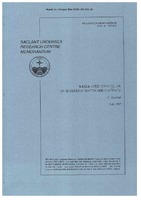| dc.description.abstract | which, when used as input to a forward model, accurately model the observed data. It is also useful to have some indication of the uncertainty of the estimated parameters. SAGA is a software package that helps the user determine the best set of parameters to match a given data set. At present, the package consists of seven modules, one for each forward model. The forward codes are: OAST (wavenumber integration transmission loss model), OAST (wavenumber integration reflection coefficients model), SNAP (normal modes), SNAPRD (adiabatic normal modes), POPP (normal mode reverberation model), PROSIM (broadband adiabatic normal modes), and TPEM (tropospheric parabolic equation). Several types of observed data can be used in these inversions: single or multi-frequency pressure on a vertical array, coherent or incoherent transmission loss, reflection coefficients, reverberation data, or tropospheric electromagnetic data. For any parameter estimation problem the issue of error assessment must be addressed. In SAGA it is addressed by estimating a posteriori distributions. The word SAGA stems from Icelandic and simply means a long story, usually from the middle ages. It tends to go on forever. Scientifically it stands for Seismo-Acoustic inversion using Genetic Algorithms. | |
